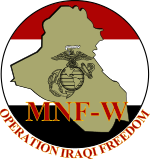Multi-National Force West

| Multi-National Forces West | |
|---|---|
 The logo for MNF-W | |
| Active | March 2004 – January 23, 2010 |
| Disbanded | January 23, 2010[1] |
| Country | |
| Allegiance | |
| Branch | United States Marine Corps |
| Type | Division |
| Role | Expeditionary combat forces |
| Size | |
| Part of | Multi-National Force – Iraq, Multi-National Corps – Iraq |
| Garrison/HQ | Camp Fallujah (2004–2008) Al Asad Airbase (2008–2010) |
| Engagements | Iraq War – Al Anbar campaign * Operation Vigilant Resolve * Operation Phantom Fury |
| Commanders | |
| Notable commanders | James T. Conway John F. Kelly |
Multi-National Forces West (MNF-W) or United States Forces West (USF-W) was one of the coalition headquarters under Multi-National Force-Iraq. It was headquartered by either I or II U.S. Marine Expeditionary Force that rotated on a 12-month basis. Their area of operations was primarily the Al Anbar province which includes the cities of Ar Ramadi, Fallujah, Al-Qa'im, and Haditha. The force was the most important U.S. unit to take part in the Iraq War in Al Anbar Governorate.
Among the smaller multinational units operating within MNF-W was a platoon from the Azerbaijani Armed Forces.
Commanders
[edit]During the Iraq War, the Marine Corps regularly rotated command of MNF-W between the 1st and 2nd Marine Expeditionary Forces.
| MEF | Commander | From | To |
|---|---|---|---|
| I MEF | James T. Conway | March 2004 | September 2004 |
| I MEF | John F. Sattler | September 2004 | February 2005 |
| II MEF | Stephen T. Johnson | February 2005 | February 2006 |
| I MEF | Richard C. Zilmer | February 2006 | February 2007 |
| II MEF | Walter Gaskin | February 2007 | February 2008 |
| I MEF | John F. Kelly | February 2008 | February 2009 |
| II MEF | Richard Tryon | February 2009 | January 23, 2010 |
For convenience, these changes of command are listed below and the Marine command in MNF-W is simply referred to as "MEF":
| I Marine Expeditionary Force | II Marine Expeditionary Force |
As the Marine Corps withdrew from Al Anbar Governorate, by September 2009 they were replaced by a single brigade, the 1st Brigade of the 82nd Airborne Division. The brigade was bolstered with an additional 16 advisers, though this did not reach the 48 assigned advisors that were supposed to be part of an 'Advise and Assist' brigade.[7]
References
[edit]- ^ Marines transfer Anbar command, exit Iraq Archived 2010-02-05 at the Wayback Machine
- ^ U.S. hands over Anbar, Iraq's once-deadliest region
- ^ Schlosser 2010, pp. 239–244
- ^ McWilliams 2009, pp. 215, 241 (Vol 1)
- ^ "Marines transfer Anbar command, exit Iraq" (Press release). 82nd Airborne Division, United States Army. 25 January 2010. Retrieved 11 December 2011.
- ^ West 2005, p. 55
- ^ Gordon, Michael R.; Trainor, Bernard E. (2012). The Endgame: The Inside Story of the Struggle for Iraq, from George W. Bush to Barack Obama. New York: Pantheon Books. p. 603. ISBN 978-0-307-37722-7.